
A daylily, day lily or ditch-lily is a flowering plant in the genus Hemerocallis, a member of the family Asphodelaceae, subfamily Hemerocallidoideae, native to Asia. Despite the common name, it is not, in fact, a lily, nor does it specifically grow in ditches. Gardening enthusiasts and horticulturists have long bred Hemerocallis species for their attractive flowers; a select few species of the genus have edible petals, while some are extremely toxic. Thousands of cultivars have been registered by the American Daylily Society, the only internationally recognized registrant according to the International Code of Nomenclature for Cultivated Plants (ICNCP).. The plants are perennial, bulbous plants, whose common name alludes to its flowers, which typically last about a day.
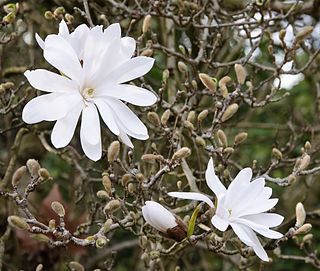
Magnolia stellata, the star magnolia, is a slow-growing deciduous shrub or small tree native to Japan. It bears large, showy white or pink flowers in early spring, before its leaves open. This species is closely related to the Kobushi magnolia, and is treated by many botanists as a variety or even a cultivar of that. However, Magnolia stellata was accepted as a distinct species in the 1998 monograph by Hunt.

Dasiphora fruticosa is a species of hardy deciduous flowering shrub in the family Rosaceae, native to the cool temperate and subarctic regions of the northern hemisphere, often growing at high altitudes in mountains. Dasiphora fruticosa is still widely referenced in the horticultural literature under its synonym Potentilla fruticosa. Common names include shrubby cinquefoil, golden hardhack, bush cinquefoil, shrubby five-finger, widdy, kuril tea and tundra rose.
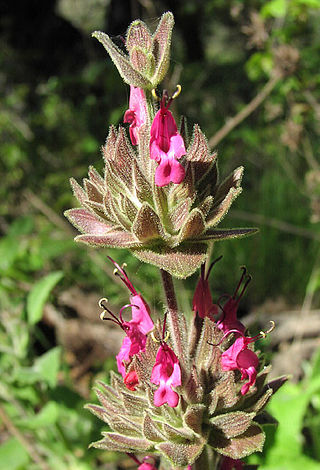
Salvia spathacea, the California hummingbird sage or pitcher sage, is a species of flowering plant in the family Lamiaceae, native to southern and central California growing from sea level to 610 m (2,001 ft). This fruity scented sage blooms in March to May with typically dark rose-lilac colored flowers. It is cultivated in gardens for its attractive flowering spikes and pleasant scent.

Hydrangea macrophylla is a species of flowering plant in the family Hydrangeaceae, native to Japan. It is a deciduous shrub growing to 2 m (7 ft) tall by 2.5 m (8 ft) broad with large heads of pink or blue flowers in summer and autumn. Common names include bigleaf hydrangea, French hydrangea, lacecap hydrangea, mophead hydrangea, and hortensia. It is widely cultivated in many parts of the world in many climates. It is not to be confused with H. aspera 'Macrophylla'.

Salvia splendens, the scarlet sage, is a tender herbaceous perennial plant native to Brazil, growing at 2,000 to 3,000 m elevation where it is warm year-round and with high humidity. The wild form, rarely seen in cultivation, reaches 1.3 m (4.3 ft) tall. Smaller cultivars are very popular as bedding plants, seen in shopping malls and public gardens all over the world.

Celosia argentea, commonly known as the plumed cockscomb or silver cock's comb, is a herbaceous plant of tropical origin in the Amaranthaceae family from India and Nepal. The plant is known for its very bright colors. In India and China it is known as a troublesome weed.
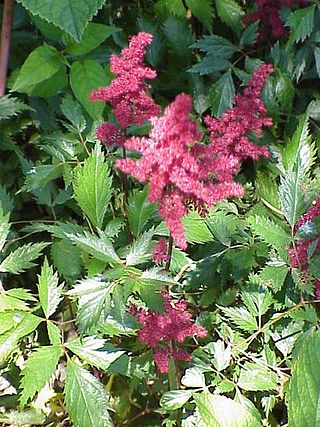
Astilbe is a genus of 18 species of rhizomatous flowering plants within the family Saxifragaceae, native to mountain ravines and woodlands in Asia and North America. Some species are known by the common names false goat's beard and false spirea.

Dracaena reflexa is a tree native to Mozambique, Madagascar, Mauritius, and other nearby islands of the Indian Ocean. It is widely grown as an ornamental plant and houseplant, valued for its richly coloured, evergreen leaves, and thick, irregular stems.

Salvia greggii, the autumn sage, is a herbaceous perennial plant native to a long, narrow area from southwest Texas, through the Chihuahuan Desert and into the Mexican state of San Luis Potosi, typically growing in rocky soils at elevations from 5,000 to 9,000 ft. It was named and described in 1870 by botanist Asa Gray after Josiah Gregg, a merchant, explorer, naturalist, and author from the American Southwest and Northern Mexico, who found and collected the plant in Texas. It is closely related to, and frequently hybridizes with, Salvia microphylla. Despite the common name "autumn sage", it blooms throughout the summer and autumn.

Salvia fulgens, the Cardinal sage or Mexican scarlet sage, is a species of flowering plant native to the Mexican mountains adjacent to the state of Puebla, growing at 8,700-11,000 ft elevation. It prefers the edge of oak and coniferous woodlands, especially in clearings of Abies religiosa. The mountains receive fog and rain nearly year-round.

Salvia involucrata, the roseleaf sage, is a species of flowering plant in the sage family Lamiaceae. This herbaceous perennial is native to the Mexican states of Puebla, Tamaulipas, and Veracruz, growing in shady places such as the edge of forests. Its specific epithet involucrata refers to the prominent flower bracts, which are large and colorful.

Salvia is the largest genus of plants in the sage family Lamiaceae, with nearly 1000 species of shrubs, herbaceous perennials, and annuals. Within the Lamiaceae, Salvia is part of the tribe Mentheae within the subfamily Nepetoideae. One of several genera commonly referred to as sage, it includes two widely used herbs, Salvia officinalis and Salvia rosmarinus.
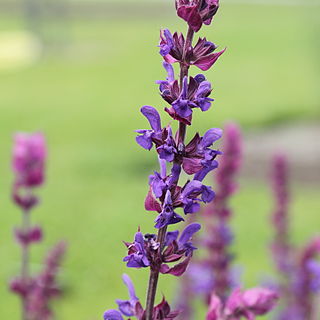
Salvia nemorosa, the woodland sage, Balkan clary, blue sage or wild sage, is a hardy herbaceous perennial plant native to a wide area of central Europe and Western Asia.

Forsythia × intermedia, or border forsythia, is an ornamental deciduous shrub of garden origin.

Geranium subcaulescens is a species of flowering plant in the geranium family Geraniaceae, that is native to Italy, Turkey and the Balkans. A low, mounded evergreen perennial, it typically grows to 8 in (20 cm) tall by more than 11 in (28 cm) broad, with grey-green orbicular and lobed leaves, and masses of bright magenta pink flowers with black centres in summer.

Acer palmatum, commonly known as Japanese maple, palmate maple, or smooth Japanese maple (Korean: danpungnamu, 단풍나무, Japanese: irohamomiji, イロハモミジ, or momiji,, is a species of woody plant native to Korea, Japan, China, eastern Mongolia, and southeast Russia. Many different cultivars of this maple have been selected and they are grown worldwide for their large variety of attractive forms, leaf shapes, and spectacular colors.
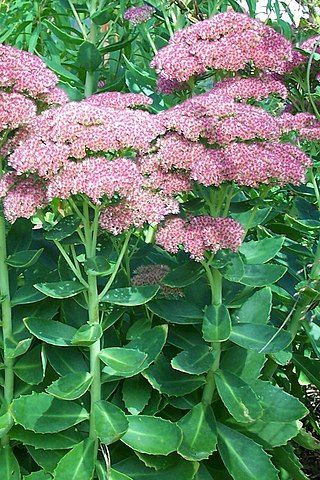
Hylotelephium, syn. Sedum, is a genus of flowering plants in the family Crassulaceae. Various species have been hybridized by horticulturalists to create new cultivars. Many of the newer ones are patented.

Plectranthus oertendahlii is a species of flowering plant in the sage and mint family, Lamiaceae. Common names include silverleaf spurflower, Swedish ivy, Oertendahl's spurflower, November lights and Brazilian coleus, though it is native to eastern South Africa rather than Brazil. Plectranthus oertendahlii and the cultivar ‘Uvongo’ have gained the Royal Horticultural Society’s Award of Garden Merit.

Saxifraga fortunei (齿瓣虎耳草), the fortune saxifrage, is a species of flowering plant in the family Saxifragaceae, native to China, Japan and Korea. Growing to just 40 cm (16 in) tall and broad, it is a shade-loving herbaceous perennial with large round fleshy leaves. Slender branched stalks bear panicles of small white starry flowers in summer. The two lower petals of each bloom are significantly longer than the others. Both the flowers and the leaves are sometimes flushed red or pink.























